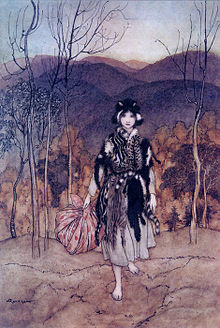
Illustration by Arthur Rackham
"Donkeyskin" is a popular Fairy Tale transcribed by Charles Perrault in 1697. It's also known as "All-Kind-of-Furs", "The Coat of All Colors" and/or "Allerleiuh" (by The Brothers Grimm in 1812), and has been adapted as "Sapsorrow" in The Storyteller, Deerskin by Robin McKinley, in 1970 adapted as a musical by Jacques Demy, and made into an episode of the 1987-1990 anime Grimm's Fairy Tale Classics.
A king loses his wife; on her death bed, she demands that he promise not to remarry except to a woman more beautiful than she is. The king finds it impossible to find such a woman, until he realizes that his daughter is the only one who surpasses her mother's beauty.
The king therefore plans to marry his daughter. The princess in despair begs for her Fairy Godmother's help, and the godmother advises her to declare that she will not marry unless she is brought three impossible dresses: one which is of the color of sky, one which shines like the moon, and a third like the sun. When the king succeeds in providing each of these three dresses in turn, the fairy godmother advises the princess to ask for the skin of the king magic's donkey, from the ears of which tumble gold pieces. Despite the animal's usefulness, the king slaughters it and presents the unfortunate princess with the skin. The princess then decides to run away, and on her fairy godmother's advice clothes herself in the donkey's skin so that no one will recognize her.
She travels to a far-away kingdom, and takes a menial job at a farm, calling herself "Donkeyskin." The kingdom's prince happens to pass by Donkeyskin's hut while she is entertaining herself by dressing up in her sun-gold dress. He is very taken with her, and in an effort to ascertain her identity he requests that she bake him a cake, in which he finds the princess's ring. The prince then announces that he will marry only the girl on whose finger the ring fits, and tries it on every woman in the kingdom. When the ring fits Donkeyskin's finger, her identity is revealed and the two are married.
The Aarne-Thompson Number is type 510B, "unnatural love".
"Donkeyskin" and its variations contain the following tropes:[]
- Bowdlerise: In Victorian era, the fact that the donkey could poop gold was changed, and since then the coins tumble from its ears.
- Fairy Godmother: Perhaps the most famous example alongside "Cinderella".
- The Girl Who Fits This Slipper
- Impossibly Cool Clothes: The three dresses, the whole point of which is that they're so impossibly cool that the princess hopes her father will not be able to supply them. The golden dress really does shine like the sun; it's not possible to look directly at it with unshielded eyes. Some versions, such as "Sapsorrow," also describe one of the dresses as "sparkling with stars."
- No Antagonist: Not even the king, in many versions of the story. He's forgiven at the very end, and even finally remarries a beautiful widow queen. This is not necessarily true in adaptations, since attempted Parental Incest makes a character pretty unsympathetic to modern audiences.
- Princess Incognito
- Prince Charming
- Rule of Three: The three dresses. Sometimes the heroine wears them at three different balls.
